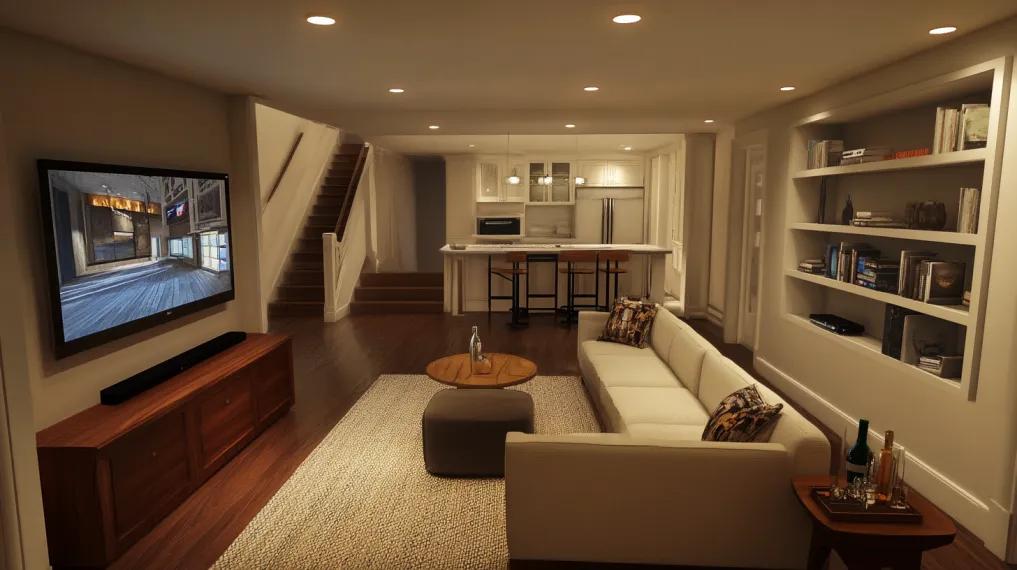How to Keep a Basement Warm in the Winter

When the winter chill sets in, many homeowners find that their basements can become uncomfortably cold. Whether you use your basement for storage, as a living space, or as a laundry room, you need to keep it warm for comfort and functionality.
HVAC.com explores effective strategies on how to keep a basement warm in winter. With a few adjustments and improvements, you can turn that frigid space into a cozy place to relax and work during the cold months.
Challenges of Basement Heating
Basements tend to be colder than the rest of the house for a few reasons, including:
- Location: Basements are partially or fully underground, surrounded by cold earth that can draw heat away from the space.
- Poor Insulation: Many basements lack adequate insulation, allowing cold air to seep in and warm air to escape.
- Inadequate Heating: Traditional heating systems like furnaces may not be set up to effectively distribute heat to a home’s basement.
How to Keep a Basement Warm
Some common tips to keep your basement more comfortable include:
1. Adding Insulation
One of the most effective ways to keep your basement warm in winter is improving insulation. Here are some areas to focus on:
- Walls: Insulating the walls can significantly reduce heat loss. Consider using foam board insulation or fiberglass batts to prevent heat from escaping through cinder block walls.
- Floors: Insulating the basement floor can help prevent heat from escaping through the concrete. You can install rigid foam insulation beneath carpets or flooring materials.
- Between Floor Joists: Adding insulation between the floor joists helps reduce heat loss to the living areas above and can significantly improve comfort levels in your basement.
- Rim Joists and Headers: These areas are often neglected but can be significant sources of heat loss. Use spray foam insulation or fiberglass to seal these gaps effectively.
2. Sealing Drafts and Leaks
Drafts can be a major cause of cold basements. Some effective strategies to seal them include:
- Check for Gaps: Inspect areas around windows, doors, and where the walls meet the floor for any gaps. Use caulk or weatherstripping to seal these openings.
- Cover Vents: If your basement has air vents that lead outside, close them during winter to keep cold air from entering.
- Basement Doors: If your basement has an exterior door, make sure it’s properly sealed. A door sweep can help prevent cold air from seeping in.
3. Heating Solutions
Adding a heating system is a great way to keep a basement warm in the winter. It may be possible to run ductwork to your basement and heat the space with your home’s existing heating system, depending on system capacity. Or, you can use dedicated heating equipment for the basement, such as:
- Space Heaters: Portable electric space heaters can be a quick solution to warm up a cold basement. Just be sure to choose a model with safety features, and never leave it unattended.
- Radiant Floor Heating: For a more permanent solution, radiant floor heating can be installed beneath the flooring. This type of heating radiates warmth upward, making the space much more comfortable.
- Ductless Mini-Splits: Ductless mini-split systems are another excellent option for basement heating. These systems allow for precise temperature control and can efficiently heat individual rooms and areas without the need for ductwork.
4. Humidity Control
Maintaining the right humidity levels keeps your basement warm and comfortable. Unfortunately, moisture issues are quite common in many basements due to a lack of insulation and moisture infiltration. Here’s how you can manage humidity to keep a basement warm in winter:
- Humidifiers: In winter, humidity levels can drop, causing your basement to feel even colder. A humidifier can help balance moisture levels, making the space feel warmer.
- Moisture Barriers: If your basement is prone to dampness, install moisture barriers on the floors and walls. This can help prevent cold moisture from seeping in and affecting your heating efforts.
5. Using Area Rugs and Drapes
In addition to structural improvements, simple decor changes can also make your basement warmer:
- Area Rugs: Placing rugs on concrete floors can add warmth and comfort. Rugs provide insulation and help retain heat in the room.
- Drapes: Heavy drapes or thermal curtains on basement windows can block drafts and keep the cold out. This simple addition can make a significant difference in warmth.
6. Closing Off Utility Spaces
Utility spaces, such as water heater rooms, laundry areas, or unfinished sections of the basement, are typically unheated, but can contribute to heat loss if not managed properly. By closing off these areas, you can help maintain a warmer temperature in other areas of your basement.
- Seal Off Utility Rooms: If your basement has utility rooms or storage spaces that are rarely used, consider closing the doors to these areas. This helps contain the heat within the main living space of the basement.
- Use Insulated Doors: If possible, replace standard doors with insulated doors in utility spaces. This adds an extra layer of protection against drafts and heat loss, ensuring that the warmth from your living area doesn’t escape.
- Insulate the Walls: If you have utility areas that are exposed to cold air, insulate the walls separating these spaces from the main basement. This not only helps to keep the basement warmer but also protects the utility systems from extreme temperatures, prolonging their lifespan.
- Ventilation Control: While some ventilation is necessary for utility spaces, you can control it to minimize heat loss. Make sure that any vents leading to cold areas are adjustable, so you can close them during the winter months while ensuring that systems like water heaters still have adequate airflow.